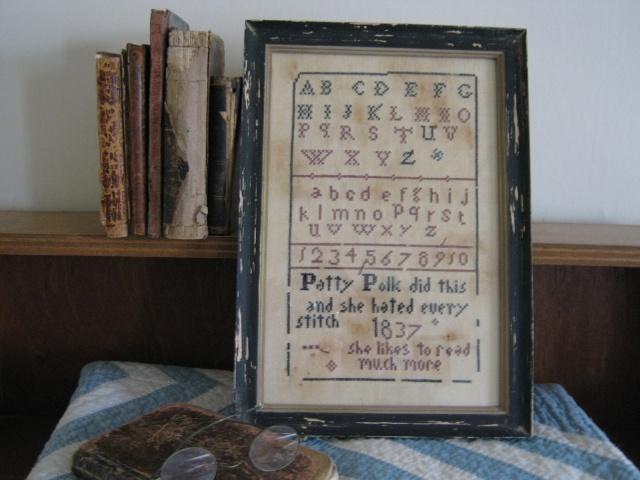Mark Dominus (陶敏修)
mjd@pobox.com

Archive:
| 2024: | JFMA |
| 2023: | JFMAMJ |
| JASOND | |
| 2022: | JFMAMJ |
| JASOND | |
| 2021: | JFMAMJ |
| JASOND | |
| 2020: | JFMAMJ |
| JASOND | |
| 2019: | JFMAMJ |
| JASOND | |
| 2018: | JFMAMJ |
| JASOND | |
| 2017: | JFMAMJ |
| JASOND | |
| 2016: | JFMAMJ |
| JASOND | |
| 2015: | JFMAMJ |
| JASOND | |
| 2014: | JFMAMJ |
| JASOND | |
| 2013: | JFMAMJ |
| JASOND | |
| 2012: | JFMAMJ |
| JASOND | |
| 2011: | JFMAMJ |
| JASOND | |
| 2010: | JFMAMJ |
| JASOND | |
| 2009: | JFMAMJ |
| JASOND | |
| 2008: | JFMAMJ |
| JASOND | |
| 2007: | JFMAMJ |
| JASOND | |
| 2006: | JFMAMJ |
| JASOND | |
| 2005: | OND |
Subtopics:
| Mathematics | 238 |
| Programming | 99 |
| Language | 92 |
| Miscellaneous | 67 |
| Book | 49 |
| Tech | 48 |
| Etymology | 34 |
| Haskell | 33 |
| Oops | 30 |
| Unix | 27 |
| Cosmic Call | 25 |
| Math SE | 23 |
| Physics | 21 |
| Law | 21 |
| Perl | 17 |
| Biology | 15 |
Comments disabled
Mon, 11 Apr 2016
Recently the following amusing item was going around on Twitter:
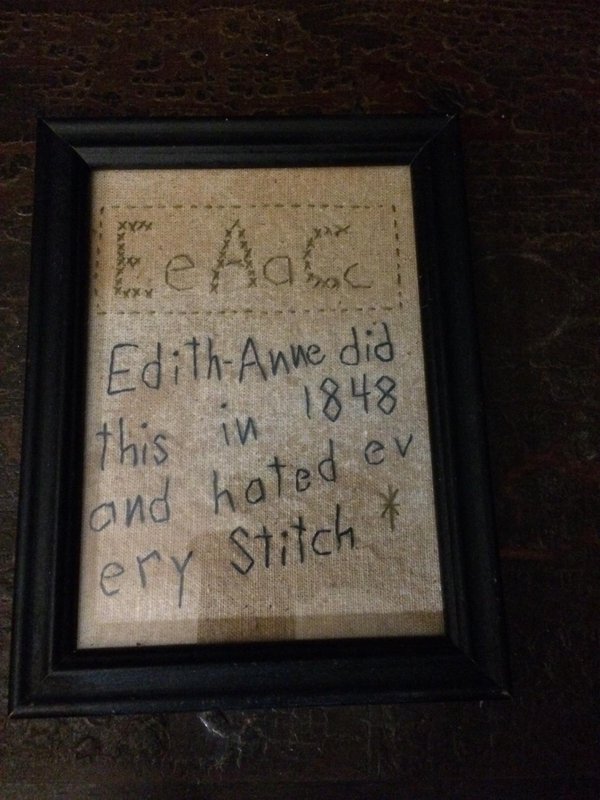
I have some bad news and some good news. First the good news: there is an Edith-Anne. Her name is actually Patty Polk, and she lived in Maryland around 1800.
Now the bad news: the image above is almost certainly fake. It may be a purely digital fabrication (from whole cloth, ha ha), or more likely, I think, it is a real physical object, but of recent manufacture.
I wouldn't waste blog space just to crap on this harmless bit of fake history. I want to give credit where it is due, to Patty Polk who really did do this, probably with much greater proficiency.
Why I think it's fake
I have not looked into this closely, because I don't think the question merits a lot of effort. But I have two reasons for thinking so.
The main one is that the complaint “Edith-Anne … hated every Stitch” would have taken at least as much time and effort as the rest of the sampler, probably more. I find it unlikely that Edith-Anne would have put so much work—so many more hated stitches—into her rejection.
Also, the work is implausibly poor. These samplers were stitched by girls typically between the ages of 7 and 14, and their artisanship was much, much better than either section of this example. Here is a sampler made by Lydia Stocker in 1798 at the age of 12:
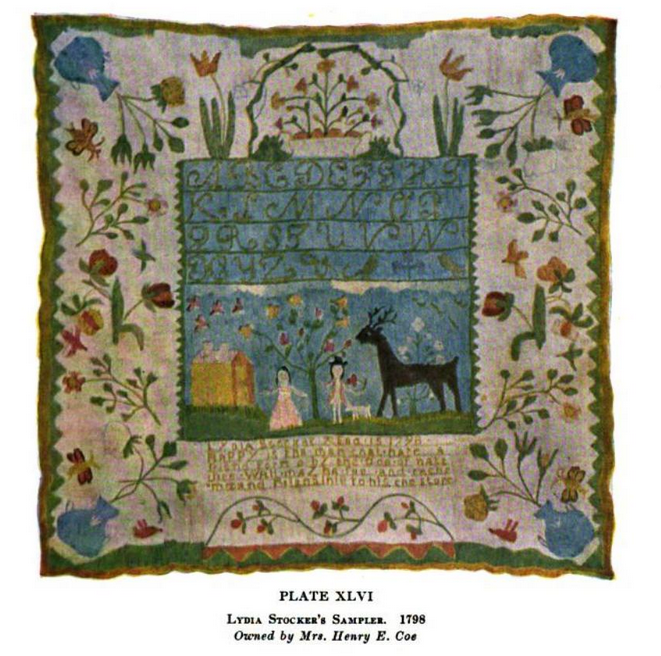
Here's one by Louisa Gauffreau, age 8:
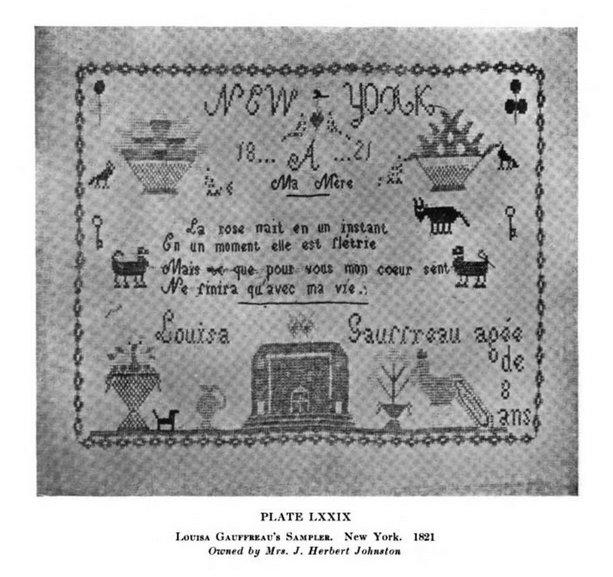
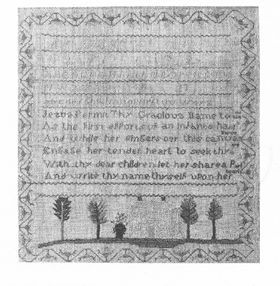 Compare these
with Edith-Anne's purported cross-stitching. One tries to imagine how
old she is, but there seems to be no good answer. The crooked
stitching is the work of a very young girl, perhaps five or six. But
the determination behind the sentiment, and the perseverance that
would have been needed to see it through, belong to a much older girl.
Compare these
with Edith-Anne's purported cross-stitching. One tries to imagine how
old she is, but there seems to be no good answer. The crooked
stitching is the work of a very young girl, perhaps five or six. But
the determination behind the sentiment, and the perseverance that
would have been needed to see it through, belong to a much older girl.
Of course one wouldn't expect Edith-Anne to do good work on her hated sampler. But look at the sampler at right, wrought by a young Emily Dickinson, who is believed to have disliked the work and to have intentionally done it poorly. Even compared with this, Edith-Anne's claimed sampler doesn't look like a real sampler.
Patty Polk
Web search for “hated every stitch” turns up several other versions of Edith-Anne, often named Polly Cook1 or Mary Pitt2 (“This was done by Mary Pitt / Who hated every stitch of it”) but without any reliable source.
However, Patty Polk is reliably sourced. Bolton and Coe's American Samplers3 describes Miss Polk's sampler:
POLK, PATTY. [Cir. 1800. Kent County, Md.] 10 yrs. 16"×16". Stem-stitch. Large garland of pinks, roses, passion flowers, nasturtiums, and green leaves; in center, a white tomb with “G W” on it, surrounded by forget-me-nots. “Patty Polk did this and she hated every stitch she did in it. She loves to read much more.”
The description was provided by Mrs. Frederic Tyson, who presumably owned or had at least seen the sampler. Unfortunately, there is no picture. The “G W” is believed to refer to George Washington, who died in 1799.
There is a lively market in designs for pseudo-vintage samplers that you can embroider yourself and “age”. One that features Patty Polk was produced by Falling Star Primitives:
Thanks to Lee Morrison of Falling Star Primitives for permission to use her “Patty Polk” design.
References
1. Parker, Rozsika. The Subversive Stitch: Embroidery and the Making of the Feminine. Routledge, 1989. p. 132.
2. Wilson, Erica. Needleplay. Scribner, 1975. p. 67.
3. Bolton, Ethel Stanwood and Eva Johnston Coe. American Samplers. Massachusetts Society of the Colonial Dames of America, 1921. p. 210.
[ Thanks to several Twitter users for suggesting gender-neutral vocabulary. ]
[ Addendum: Twitter user Kathryn Allen observes that Edith-Anne hated cross-stitch so much that she made another sampler to sell on eBay. Case closed. ]
[ Addendum: Ms. Allen further points out that the report by Mrs. Tyson in American Samplers may not be reliable, and directs me to the discussion by J.L. Bell, Clues to a Lost Sampler. ]
[ Addendum 20160619: Edith-Anne strikes again!. For someone who hated sewing, she sure did make a lot of these things. ]
[ Addendum 20200801: More about this by Emily Wells, who cites an earlier Twitter thread by fashion historian Hilary Davidson that makes the same points I did: “no matter how terribly you sewed in 1877, it would have been impossible to sew badly like this for a middle-class sampler”. ]
[ Addendum 20211011: Ms. Wells’ article also explains the connection between Patty Polk and Mrs. Tyson, who I said “presumably owned or had at least seen the sampler.”:
Patty Polk was Martha E. Polk, the daughter of Joseph Polk and Margaret Durborough. Born on March 2, 1817, Polk likely completed her needlework picture at some point in the 1830s. In 1921, Polk’s daughter, Florence McIntyre Tyson, submitted her mother’s sampler for inclusion in Bolton and Coe’s American Samplers.
]
[Other articles in category /misc] permanent link



